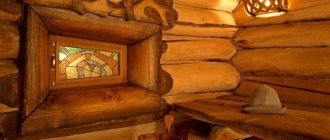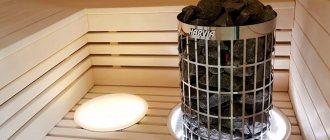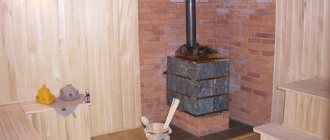If you know which stones are best to choose for a bath , then you can increase the effectiveness of the healing procedure several times, of course, if you give preference to natural materials and take into account their characteristics. Proper use not only allows you to increase the temperature, but also contributes to its better preservation due to the heat capacity of the stones.
By the way, we recommend paying attention to a good assortment of bath stones in the Teplokontakt online store. There is a large selection of various products for baths and saunas, which can be ordered with delivery throughout Russia.
What properties should stones for a bath have?
To correctly determine which bath stones are suitable for your steam room, you should first understand the basic characteristics of these stones. They must have the following properties:
- Density. The heavier the stone, the more suitable it is for a bath or sauna.
- Heat resistance - the ability to experience systematic heating to very high temperatures.
- Heat capacity is the ability of a stone to store heat and smoothly release it into the environment. The greater the heat capacity of the rock, the longer the bath will remain heated.
- Environmentally friendly : when heated, the stone should not emit harmful substances.
- Uniformity of structure . It is not recommended to use stones with inclusions and veins in baths. Otherwise, heating will occur unevenly, which will quickly lead to destruction.
It is best to use stones with a uniform structure
- No cracks. You can check the stones by knocking them against each other. If everything is in order, the sound will be clear and clear.
There are two opinions about the size of the stones. Some people think that they should be the same size. Then the heater will heat up evenly and release heat evenly.
Others say that it is better to choose stones of different sizes. Moreover, the largest ones should be placed down, medium ones above, and small ones at the top. This is necessary so that the large lower stones store heat and retain it for a long time, releasing it a little at a time and maintaining the temperature of the rest of the heater.
There is no clear answer to the question of which stones are better for a bath, the same or different in size: both methods have proven themselves well.
Now about smooth and chipped stones. The first ones serve for a very long time, do not crack or delaminate. The latter give off heat more intensely due to their large surface area, but require frequent replacement. Here the choice is yours.
Heat exchange in crushed stones is more intense than in smooth ones
Before laying, stones can be tested for heat resistance. To do this, they need to be heated over a fire, and then immediately lowered into a bucket of cold water. If no cracks appear, then the stone will last a long time.
What to choose?
Yes, we've finally reached this point. Here we can give you two good directions to think about.
Universal option
Jadeite or jade, they are suitable for any stove. Jadeite is a little better, but a little less durable. These minerals can be safely recommended to everyone. If you don’t want to worry about it, but just go and buy, then this is your option.
If you are not satisfied with the price, then pay attention to soapstone. It performs well, is safe, and is durable enough that you won't regret the purchase. Even experienced bath attendants respect this stone.
According to the furnace design
So, for example, if stones come into contact with the metal structure of the stove or open fire (continuously or occasionally), i.e. are exposed to high temperatures, then you should choose the most heat-resistant stones :
Chromite
Vulcanite
Soapstone chlorite
If the stones are not subjected to extreme loads, then the classic options are your choice:
jadeite and jade
gabbro-diabase
It’s probably worth making an important caveat here. After all, to tell the truth, any of the previously listed stones are absolutely suitable for use. If a stone is on this list, then it already deserves to be in your oven. And the disadvantages that we are finding fault with here are not that significant.
What types of stones are suitable for a bath?
Now let's talk about which stones are suitable for use in a bath or sauna, depending on their breed. Traditionally, everyone tries to choose natural samples, the shape of which was created by nature itself.
You can also find synthetic bath stones on sale, but it is worth remembering that they do not have any healing properties.
Jadeite and its unique properties
Greenish colored stone. Of all those used for laying the heater, it is considered the most beautiful. It belongs to semi-precious rocks, so it is expensive.
Jadeite is a very beautiful stone
In addition to appearance, jadeite has other advantages:
- High heat capacity . The breed retains energy for an amazingly long time.
- Healing vapors when heated. The stone has a beneficial effect on the genitourinary and endocrine systems, and also accelerates the blood.
- Low moisture absorption. Therefore, high-quality steam is released.
Since it is too expensive to lay the entire heater with this type of stone, you can buy several copies and place them at the very top. A kilogram of jadeite will be quite enough for a medium-sized bathhouse.
Doctors say that jadeite is suitable for those with joint problems. It emits positive infrared radiation, ionizes the air and enriches water with metasilicic acid. Therefore, jadeite is suitable for those who are thinking about the question of which stones are best for a bath in a steam room for health.
The healing properties of jadeite have long been proven
The service life of this breed reaches seven years. But after five years it begins to gradually lose its effectiveness.
Crushed jadeite is more suitable for a Russian bath. Due to its large area, it produces a lot of steam. Polished stones are best used in a sauna.
Soapstone for baths and saunas
Soapstone is a beautiful and durable gray stone. It heats up quickly and accumulates heat well. A heater made of this type produces light and pleasant steam.
But for those who are thinking about which stones to choose for a bath and are considering soapstone, it is worth remembering that this is a very dusty rock. Although the problem can be solved: before laying, all stones must be thoroughly washed and dried in the sun.
The homeland of soapstone is Karelia and Finland. Therefore, it is considered a classic sauna stone.
Soapstone - a traditional stone for saunas
See also: Catalog of stone bath projects
Raspberry quartzite
When thinking about which stones are best for a sauna stove, you should pay attention to crimson quartzite. The breed has a bright brown-purple color. It stores and releases heat well and does not absorb moisture. It is considered the most crack-resistant stone. You can even pour ice water onto a hot stove lined with crimson quartzite.
Scientists know a lot about the healing properties of crimson quartzite:
- Normalizes blood pressure and strengthens the circulatory system.
- Pain relief for joints.
- Treats migraines and helps with problems associated with weather changes.
- Regulates the functioning of the reproductive system.
Crimson quartzite is a beautiful red-brown stone.
But the most important quality of raspberry quartzite or porphyry, as it is also called, for a bathhouse is that it can produce light steam for a long time, even after the stove is stopped. Therefore, washing in such a steam room is easy and pleasant.
What other stones are suitable for a bath?
When talking about which stones are best for a steam bath, you should pay attention to the following rocks:
- White quartz is a translucent stone. It looks very impressive in the heater, because when heated it creates a glow, which is why it got the name “hot ice”. However, white quartz is fragile and unstable to high temperatures, so it is better to use it in open-type heaters. Although it is an expensive stone, it will not last long.
White quartz is a beautiful but short-lived stone
- Gabbro-diabase is a durable stone that accumulates heat well. In many ways similar to soapstone. But there is a big difference in price. Gabbro-diabase is much cheaper, so it is found in many steam rooms.
Gabbro-diabase - a budget option for a bath or sauna
- Basalt is a black stone. It lasts for a very long time, most likely the heater will not have to be updated until the very end of the bath’s operation. This is due to its high density and strength, low water absorption and resistance to sudden and frequent temperature changes. In addition, it has a surprisingly high heat capacity.
Basalt is popular among all fans of the Russian bath
See also: Catalog of companies that specialize in the construction of baths and related work
- Sea pebbles. Interested in those who are wondering which stones are suitable for a steam bath, but are willing to spend a small amount on the purchase. To lay the heater, you can only take samples that have not been in contact with sea or river water for a long time. The fact is that if the stone is not sufficiently dried, then when heated it will give off an unpleasant odor. The structure of “wet” stone is also more prone to cracking.
Sea pebbles are the most affordable stone for a bath.
The heater in the steam room can also be made of such rocks as:
- Neuritis
- Jasper
- Chromite
- Dunit
- Dolerite
- Granite
Popular minerals and their comparison
Minerals of volcanic origin are recognized as the best filler for sauna stoves. When heated, they emit infrared radiation, easily withstand significant temperature changes and enrich the steam room air with microelements beneficial to health.
Let's look at the most popular types and their characteristics in the table and compare them with each other.
| Breed | Heat capacity, J | Strength, MPa | Density, kg/m3 | Healing properties | Nuances |
| Chromite | 920 | 300-700 | 4500 | Strengthens the immune system, helps with diseases of the reproductive system | Depending on the deposit, it may contain Mg, Al, Zn |
| Peridotite (dunite) | 1000 | 250 | 3200 | Normalizes blood pressure, helps cure colds | Purifies the air, captures carbon dioxide |
| Soapstone chlorite | 980 | 100-450 | 2980 | Strengthens the immune system, stimulates the synthesis of vitamin D, strengthens the musculoskeletal system | Can store heat for 24 hours, considered a classic option for Finnish saunas |
| Quartzite (crimson, gray, yellow) | 700 | 200-250 | 2630 | Will be useful in the treatment of vegetative-vascular dystonia, joint and pulmonary diseases | Heats up quickly, but also cools down quickly, produces light steam |
| White quartz | 750 | 200 | 2650 | Stimulates the functioning of the brain and nervous system, enriches the blood with oxygen | When heated and sharply cooled, it releases atomic oxygen |
| Porphyrite | 830 | 400 | 1450 | Improves skin condition, relieves headaches, strengthens the immune system and cardiovascular system | Depending on the composition, basalt, pyroxene, diorite and diabase porphyrite are distinguished |
| Basalt | 840 | 400 | 2500-2970 | Relieves stress and migraines, has a beneficial effect on the nervous and immune systems | Maintains heat for a long time, produces intense steam, has a long service life |
| Gabbro-diabase | 600-800 | 311 | 3070 | General health effect, no unique healing properties noted | If you come across stones containing sulfites, they will emit a burning odor when heated |
As for the price, the most budget-friendly among natural fillers will be gabbro-diabase and basalt (25-30 rubles per 1 kg). Quartz will cost the most - from 60 rubles / kg.
Is it worth collecting stones for a bath?
The question of whether it is possible to collect valuable and effective rocks worries many who wonder how to choose stones for a bath. After all, this is a real opportunity to save money and at the same time create a high-quality heater.
It is quite possible to collect stones for a bath with your own hands
Most often, a stone suitable for a bath can be found on the slopes of mountains, on the shores of seas or rivers. Moreover, everything found near fresh water bodies will be of higher quality than marine samples. Although both stones were subjected to long-term processing by nature, the influence of sea water has a detrimental effect on the strength of the rock.
But when collecting stones yourself, you need to remember that many rocks can only be mined industrially. For example, gabbro-diabase, quartzite and jadeite will not lie on the surface. Therefore, manual collection implies that you will have to use only those specimens that you can find.
At the same time, there are many specialized stores that sell any breed. Here you can decide which bath stones are best to buy with unlimited choice.
Often, balanced sets with certain properties are created from stones. In this case, it is quite possible to line 80% of the heater with pebbles collected by yourself, and the remaining 20% with purchased valuable rocks.
Specialized stores offer a large selection of bath stones
Which ones should not be used?
You should always pay attention to health safety. You cannot buy stones from a manufacturer that does not provide a certificate of conformity. And if you collect pebbles yourself, then it is better to check them with a dosimeter. The rock that emits radiation is usually found in nature on the territory of mines, shafts and dumps. These varieties include granite and marble.
You cannot decorate steam rooms with stones collected near railways and roads. They are full of exhaust fumes, creosote and road dust.
Soft rocks are not strong enough. They do not warm up well and transfer energy. These include sandstone and limestone.
Cracked stones are dangerous for humans. With sudden changes in temperature, they split and can injure the person in the steam room.
How to lay stones in a stove
The heating rate of the heater directly depends on the installation method. A conventional stove for a Russian bath requires gradual, uniform heating. The heating process is a long-term operation, and active steam formation will begin after all the fuel has burned out. Proper placement of stones can significantly reduce the time it takes to get the steam room into working condition.
Proper installation of the heater is the key to quick heating
The two most important characteristics of bath stones are heat capacity and thermal conductivity. It is better to place stones that are more thermally conductive, but have less heat capacity, closer to the fire. This way heat will be transferred faster from bottom to top. This rule is especially relevant when using different breeds.
It is advisable to place stones of different fractions in the heater: the smaller, the higher. After all, the larger the stone, the longer and more intensely it needs to be heated. Small stones are necessary in order to create a large heat transfer area.
Smaller stones should be placed on top
Selecting breeds from an environmental safety point of view
Minerals of uniform color are considered safe for health:
- dunites;
- jadeites;
- peridotites.
Cast iron and ceramics are not dangerous.
You should not use stones containing:
- sulfides;
- creosote;
- inclusions of rich red and yellow shades;
- with a metallic sheen.
You cannot collect granite, crushed stone, or paving stones for a bathhouse near highways or railroad tracks.
It is better to buy stones for backfilling in a store and demand quality certificates from sellers, which will indicate that the product has passed radio control.
An excellent option for finishing the walls of a steam room is salt stones. Beneficial vapors will protect against possible allergens.
Proper care of bath stones
Even natural stone, a seemingly very strong and durable material, becomes unusable after some time of use in extreme bath conditions. Over the course of a year, the heat output of the furnace can decrease by 15-20%.
Due to the constant high temperature, bath stones quickly lose important properties
It is recommended to carry out a complete inspection of the entire heater at least once a year. Damage, chips, cracks are a signal. That the stone needs to be changed. After inspection, it is advisable to rinse everything with clean running water. Every two years it is worthwhile to completely replace all the stones, however, if the sauna is used relatively rarely, then the service life can reach five years.
Operating rules and advice from bathhouse attendants
It’s not enough to just choose the right stones, because you also need to position them correctly in the oven so that the heat is comfortable and the steam is fine and really light.
It is also equally important to arrange proper ventilation in a room with an electric heater or other type of stove.
In the masonry, it is necessary to provide a sufficient number of unfilled vertical channels through which hot air will circulate
Nuances of filling the stove:
- Before installation, the filler must be thoroughly washed and dried.
- The lower layers are laid in large fragments, which accumulate heat well. It can be peridotite, soapstone, gabbro-diabase, basalt or cast iron cores.
- Medium and small particles of jadeite, quartzite, jade or other rocks with suitable healing properties are placed on top.
- The stones need to be placed fairly tightly, but not compacted. After laying, the proportion of air gaps should be approximately 10-15 percent of the total volume.
- There is no need to place the filler close to the tubes and other elements of the electric heater - when heated, the stone expands and can deform the device.
- You can only pour hot water onto the heater, in small portions and without additives like honey, oils or beer, otherwise the stones will quickly become covered with soot and will smoke. If you can’t imagine a sauna without aromatic steam, simply dissolve the mixture in water, pour it into a metal bowl and place it on top or hang it over the stove for evaporation.
- Porphyrite and other rocks may crack slightly when first heated - this is normal. But if the crackling sound is heard constantly, the stones should be reconsidered and, if necessary, replaced - perhaps you received heterogeneous specimens with foreign impurities.
And lastly: do not forget to check the condition of the heater at least once a year and check the filler for cracks and breaks.
Damaged stones must be removed and replaced with new ones, and those that have adequately withstood the test of heat and steam must be washed under running water and sent back to service.
Video description
Here is an interesting video on how to wash stones for a bath:
In order for the steam room to function normally, it is necessary to correctly calculate the mass of the stones. It is believed that there should be 5-6 kg of rock per square meter. Then the desired effect and maximum durability of the heater will be achieved.
Different types of stone differ in their service life
For stoves with a closed heater, a type that is more resistant to high temperatures is needed. In open stoves, the heating is less intense, so deciding which stones are better for the heater in the bathhouse is much easier.
Peridotite
The stone is of igneous origin and comes in a wide range of colors: from light gray to black. It contains no harmful impurities, so the stone is completely safe for people. Peridotite is well suited for a bath, because it has a high heat capacity, can give off heat for a long time and can withstand temperatures up to 1800 degrees. When reacting with carbon dioxide, the stone purifies the environment.
Typically, peridotite is placed at the bottom of the furnace, and covered on top with other stones that have a more pronounced healing effect.
It is quite difficult to say which stones are the best for a bath; each rock has advantages and disadvantages. Many people do the same thing with stones as with bath brooms, that is, they try different options: first one type of stone, then after 3-4 years another. This makes steaming procedures more varied, and also helps everyone choose an option to their liking.
Do you want to steam in a sauna with pleasure and pleasure? Choose the best stones for a bath, approach the issue with all responsibility. Then you are guaranteed good and fragrant steam in the steam room!
Briefly about the main thing
The main properties of stone for a bath are heat resistance, the ability to store heat and not absorb moisture, density and uniformity of structure.
- Jadeite is an expensive and rare stone that has a healing effect on the human body.
- Soapstone is a northern stone often used for saunas.
- Crimson quartzite is a beautiful brown stone that is resistant to high temperatures and produces high-quality steam.
To lay the heater, you can use gabbro-diabase, white quartz, sea pebbles, and basalt.
You can find some types of bath stones yourself. But you shouldn't do this on a railway embankment.
You need to place stones in the heater, placing them on the bottom. At the bottom there should be the most massive specimens and the most heat-resistant rocks.
It’s not enough to know how to choose stones for a bath; you also need to carefully care for them. Be sure to wash them and periodically replace damaged ones.
Ratings 0
Basalt
The stone is formed from solidified lava of a volcano. It has a dense structure and retains heat perfectly. Basalt is the most durable of all bath stones of volcanic origin; it can withstand strong temperature changes. It heats up quickly, gives off heat for a long time and produces steam well.
Bath basalt has high antibacterial properties, it disinfects the skin, improves the functioning of the respiratory system, helps cure colds and relieves migraines.
Despite its high performance properties, basalt has a fairly low cost.
Nuances of laying out stones
There are some tips to keep in mind when laying stones. The largest cobblestones are placed downwards in the wood-burning stove, then the medium-sized ones. You should put small minerals on top. At the same time, full access of water is ensured on all tiers.
The creation of high-quality steam depends on the correct placement of blocks
If you refuse to use small stones, the liquid will penetrate onto the hot surface of the stove. This will create an unpleasant odor. If the stove is powered by an electric heating device, then small stones are used.
The correct choice of quality minerals helps create a comfortable and healing atmosphere in the steam room.
Comparative characteristics of stones
Based on the performance characteristics, a rating of a number of minerals has been compiled according to several parameters.
By service life
| Place in the ranking | Duration of operation |
| 1 | Nephritis |
| 2 | Dunit, cast iron cores |
| 3 | Chromite, porphyrite, ceramic balls |
| 4 | Raspberry quartzite |
| 5 | Jade |
| 6 | Soapstone chlorite |
| 7 | White quartz |
| 8 | Jasper, gabbro-diabase |
It is important to remember that contact of minerals with open fire, improper placement inside the furnace, or extreme heat leads to a significant reduction in service life and premature damage.
By heat capacity, strength and density
Comparative characteristics of the main indicators of the physical and mechanical properties of minerals used in heater stoves of Finnish saunas and Russian baths.
| Indicators | Jade | Basalt | Gabbro-diabase | Raspberry quartzite | Soap chloride | Porphyrite |
| Compressive strength kg/sq.cm | 20 | over 30 | 15 | 25 | 8 | 15 |
| Mohs hardness | 7 | 8 | 5-6 | 7 | 2-3 | 6 |
| Strength coefficient on a 20-point scale according to Protodyakonov | 20 | 20 | 15 | 20 | 8 | 15 |
| Specific heat capacity kJ/kg*C | 0,88 | 1,1 | 0,7 | 0,95 | 0,98 | 0,85 |
| Thermal conductivity coefficient, kcal m*h*C | 2,3-3,6 | 1,8-3,5 | 1,59-2,98 | 3,7-7,6 | 3,5-4,7 | 1,17-3,37 |
| Coefficient of linear thermal expansion 10³*1/С | 0,35-0,46 | 0,6 | 0,7 | 0,15 | 0,2 | 0,8 |
| Rock density 10³ kg/m3 | 3,2 | 2,9-3,25 | 2,9-3,0 | 2,6-2,8 | 2,8-3,0 | 2,6-2,9 |
| Porosity | 0,01-0,03 | 0,02 | 0,2 | 0,1 | 0,3 | 0,15 |
| Melting temperature | 1040-1060 | 1450 | 1250 | 1700 | 1600 | 1300 |
| Acidity module | 28 | 2,2 | 3,4 | 16 | 1 | 3,5 |
| Class of building materials | 1 | 1 | 1 | 1 | 1 | 1 |
| Heat resistance (heating-cooling cycles) | 400 | more than 1000 | 300 | 100 | 500 | 400 |
| Flaws | SiO2 content more than 50% | No | Sulfur content | Crumbles, SiO2 content is more than 50% | Content of sulfur, talc, flake flaking | Dirty gray color |
It is not recommended to use minerals containing more than 50% SiO2 in baths and saunas.
Before filling the kiln, it is recommended to always check the heat resistance of the stones. To do this, they are heated 2-3 times and lowered into a container with cold water. Elements that have cracked are removed.
Criteria for choosing stones for a sauna stove
Of course, not every stone of natural or artificial origin is suitable for use in a bathhouse. Many types of stones contain impurities in their composition, which, when heated, can release harmful substances and cause damage to health. Also, not every stone is designed to interact with high temperatures, fire and water. Therefore, you need to approach the choice of stoves for a bath wisely.
There are certain requirements that apply to stone types. We list the main ones, and then consider each requirement in more detail:
- resistance to high temperatures and temperature changes
- heat capacity (heat accumulation property)
- ecological cleanliness











